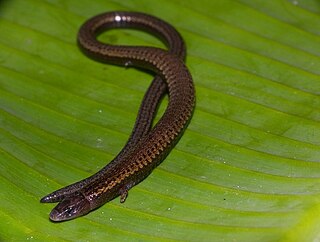
Bachia is a genus of lizards that belong to the spectacled lizards family.

Suriname toads are members of the frog genus Pipa, within the family Pipidae. They are native to northern South America and extreme southern Central America (Panama). Like other pipids, these frogs are almost exclusively aquatic.
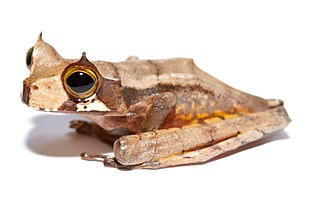
Gastrotheca is a genus of frogs in the family Hemiphractidae. They are found in Central America south of Costa Rica and in South America. Most species occur in the American Cordillera from southern Costa Rica to north-western Argentina. This genus makes up the bulk of marsupial frog diversity; formerly it was placed in the "Leptodactylidae" assemblage.
Crossodactylodes is a genus of leptodactylid frogs from the Atlantic Forest of eastern Brazil.

Dendrophryniscus is a genus of true toads in the family Bufonidae, sometimes known as tree toads. They are endemic to the Atlantic Forest of Brazil.

Osornophryne is a genus of true toads endemic to the Cordillera Central in Colombia and central Andes in Ecuador.
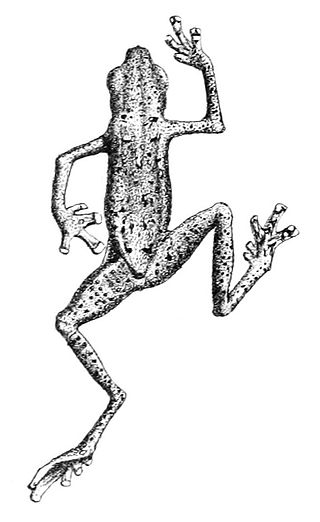
Pelophryne, commonly known as flathead toads or dwarf toads, is a genus of true toads, family Bufonidae. The genus occurs in the Philippines, Borneo, Malaya including Singapore, and Hainan (China). Molecular data suggest that Pelophryne is the sister taxon of Ansonia.

Oreobates is a genus of frogs in the family Strabomantidae. Most species were formerly in the genus Ischnocnema, but were moved to this revalidated genus following a 2006 revision. Its sister taxon is Lynchius.
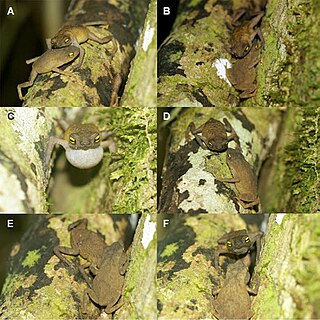
Frostius – known as Frost's toads – is a small genus of true toads consisting of only two species endemic to Brazil. The genus was proposed by David C. Cannatella in 1986 based on an analysis of a species previously classified as Atelopus. Various morphological and life-history information first suggested that it is sister taxon to Atelopus or Atelopus + Osornophryne, but later molecular evidence suggests that it is sister taxon to Oreophrynella. It was named for Darrel Frost in recognition of his work on anuran systematics.
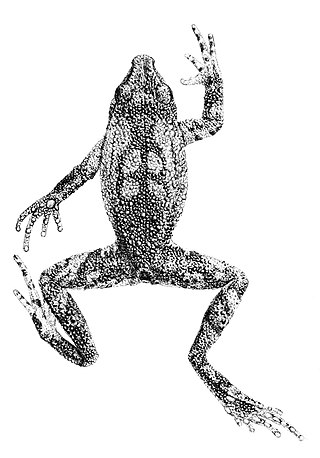
Dendrophryniscus proboscideus is a species of toad in the family Bufonidae. It is endemic to Southeastern Brazil and known from isolated records in fragments of Atlantic Forest in eastern Bahia and northeastern Minas Gerais states.

Sclerophrys is a genus of "true toads", family Bufonidae, native to Africa and the southern Arabian Peninsula. Originally, all of these species were classified in the genus Bufo. The genus, originally named Amietophrynus, was split due to large enough taxonomic divergence. Ohler and Dubois showed in 2016 that Sclerophrys capensis Tschudi, 1838 is the same species as Bufo regularis rangeri Hewitt, 1935, the type species of Amietophrynus. Because the former name is older, the implication is that Amietophrynus is a junior synonym of Sclerophrys.
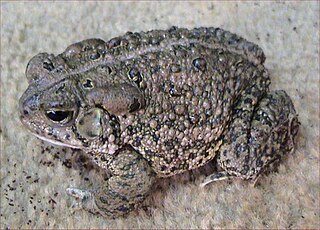
Anaxyrus, containing the North American toads, is a genus of true toads in the family Bufonidae. The genus is endemic to North and Central America, and contains many familiar North American toad species such as the American toad, Woodhouse's toad, and the western toad.

Incilius is a genus of toads in the true toad family, Bufonidae. They are sometimes known as the Central American toads or Middle American toads and are found in southern USA, Mexico, Central America, and northern Pacific South America. They are an ecologically and biogeographically diverse group of toads, including micro-endemic species such as Incilius spiculatus that are restricted to undisturbed cloud forests, and widespread lowland species such as Incilius valliceps that predominantly occur in disturbed habitats.
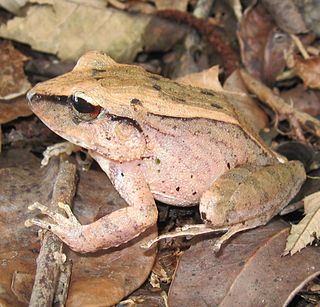
Haddadus is a genus of frogs in the family Craugastoridae. The genus has three species that are endemic to the Atlantic Forest of east and southeast Brazil. The genus is named for Célio F. B. Haddad, Brazilian herpetologist.
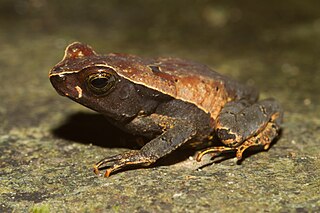
Rhaebo is a genus of true toads, family Bufonidae, from Central and South America. They are distributed from Honduras to northern South America including the Amazonian lowlands. Common name Cope toads has been suggested for them.
Colobosauroides carvalhoi is a species of lizard in the family Gymnophthalmidae. The species is native to Northeast Region, Brazil.
Leposoma sinepollex is a species of lizard in the family Gymnophthalmidae. It is endemic to Brazil. It has lanceolate ventral and elongate dorsal scales arranged in diagonal rows. Males of this species have black pigmentation in their ventral parts, while females have a creamy pigmentation.
Caligophryne is a genus of frog in the superfamily Hyloidea, clade Brachycephaloidea. It contains the single species C. doylei and is the only member of the family Caligophrynidae. It is endemic to the highest parts of the Cerro de la Neblina tepui on the border of Brazil and Venezuela.
Neblinaphryne is a genus of frog in the superfamily Hyloidea, clade Brachycephaloidea. It contains the single species N. mayeri and is the only member of the family Neblinaphrynidae. It is endemic to the highest parts of the Cerro de la Neblina tepui on the border of Brazil and Venezuela.
























